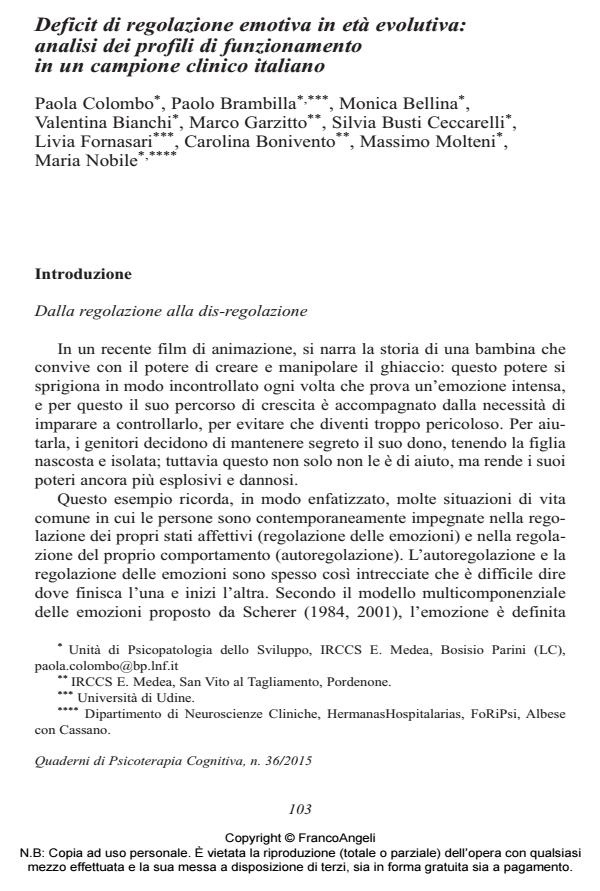Deficit of emotional self regulation among children: a features analysis on Italian clinical sample
Journal title QUADERNI DI PSICOTERAPIA COGNITIVA
Author/s Paola Colombo, Paolo Brambilla, Monica Bellina, Valentina Bianchi, Marco Garzitto, Ceccarelli Silvia Busti, Livia Fornasari, Carolina Bonivento, Massimo Molteni, Maria Nobile
Publishing Year 2015 Issue 2015/36
Language Italian Pages 13 P. 103-115 File size 139 KB
DOI 10.3280/QPC2015-036008
DOI is like a bar code for intellectual property: to have more infomation
click here
Below, you can see the article first page
If you want to buy this article in PDF format, you can do it, following the instructions to buy download credits

FrancoAngeli is member of Publishers International Linking Association, Inc (PILA), a not-for-profit association which run the CrossRef service enabling links to and from online scholarly content.
The emotional self-regulation process is recently a central topic of interest in the psychopathology studies. In developmental psychopathology a deficit of self-regulation may be involved in both externalizing and internalizing disorders. Recent studies have identified a profile for measuring self-regulatory behavior in children, using three clinical scales of the CBCL – Child Behavior Checklist: Anxiety/Depression, Attention Problems, Aggressive Behaviors. These scales were also used to identify the most severe levels of emotional dysregulation, the Dysregulation Profile. Possible clinical outcomes were identified in difficulties in mood regulation, or in thoughts/worries, or in behavior regulation, or in cognitive regulation. The present study aims to describe moderate and severe emotional dysregulation (CBCL-DESR and CBCL-DP) in a clinical sample of 1.224 Italian subjects aged 6-17. Data find the dysregulation pattern in a large part of our clinical sample, and high level of dysregulation in patients with more severe clinical features.
Keywords: Behavioral and emotion dysregulation, Child Behavior Check List, developmental psychopathology.
- Alexithymia and Psychopathological Manifestations Centered on the Body: Somatization and Self-Harm Michela Gatta, Caterina Angelico, Francesca Rigoni, Alessia Raffagnato, Marina Miscioscia, in Journal of Clinical Medicine /2022 pp.2220
DOI: 10.3390/jcm11082220
Paola Colombo, Paolo Brambilla, Monica Bellina, Valentina Bianchi, Marco Garzitto, Ceccarelli Silvia Busti, Livia Fornasari, Carolina Bonivento, Massimo Molteni, Maria Nobile, Deficit di regolazione emotiva in età evolutiva: analisi dei profili di funzionamento in un campione clinico italiano in "QUADERNI DI PSICOTERAPIA COGNITIVA" 36/2015, pp 103-115, DOI: 10.3280/QPC2015-036008